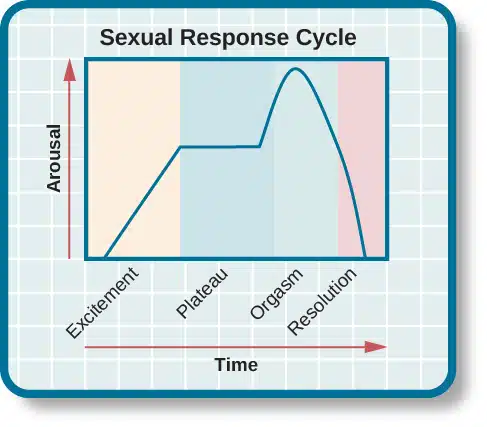
Many people probably have had the ‘birds and the bees’ talk when they were young, and most likely the information they have learned wasn’t that accurate or even scientifically correct.
The topic of sex gets thrown a lot, especially in recent years, but there are still so many taboos, myths, and misconceptions around the topic.
We’re here to take a deep dive into the topic of sex by busting myths, clarifying misconceptions, and shedding light on sex and LGBT. Before engaging in any sexual activity, always remember two things: safety and consent.
Now, let’s delve into Sex Ed 101 and collectively make 2022 the year of sex positivity!
What is Sex?

Let’s ditch the stork or the birds and the bees stories, and let’s break down what sexual activity really is.
First and foremost, people should not constrict the concept of sex to its traditional definition of “penetrative intercourse between men and a woman” or vaginal intercourse.
Since this fails to cover the wide range of sexual activities people engage in. At the end of the day, sexual activity serves humans’ innate biological need to reproduce and to fulfill the urge to engage in physical pleasure.
There are various types of sexual activities, such as sexual intercourse (PIV), anal intercourse, oral sex (cunnilingus), oral sex (fellatio), manual stimulation (hand jobs or fingering), masturbation, mutual masturbation, sexting, menage a trois, and making out.
What are the key things to remember when engaging in sexual activities?1
- Make HIV/STI testing a routine, and ask your prospective sexual partner’s status.
- Always use condoms and lube even when not doing penetrative sex.
- Stay up to date on medications, vaccines, and screenings.
- If you’re not planning to get pregnant soon, talk to a doctor about your birth control options.
- Use condoms for your sex toys and clean it every after use.
- ALWAYS ASK FOR CONSENT BEFORE DOING ANYTHING.
Open communication about sex (expectations, worries, risks, kinks/fetishes) is the primary key for satisfying and exhilarating sexual intercourse.
What is human sexuality?

In a nutshell, sexuality is all about a person’s sexual feelings, thoughts, attractions, and behaviors towards another person(s). Contrary to popular belief, it is not about who you have sex with or how often you engage in sexual intercourse.
There are various types of sexuality, and there is no hierarchy in it, as well. Everyone goes through the phase/process of figuring out their own sexuality, and that’s part of growing up.
On top of this, it’s also totally ordinary for your sexuality to change over time since sexuality is fluid.
There are various types of sexuality, such as:
- Heterosexual – people who are attracted to the opposite sex;
- Homosexual – people who are attracted to the same sex;
- Bisexual – people who are attracted to both men and women; and
- Asexual – people who experience no or very little sexual attraction.
Every person has the right to choose their own sexuality, and there is no right or wrong choice, either. The only wrong thing is when people discriminate against other people solely based on their sexuality. At this point in time, everyone should already be an LGBT+ Ally!
What are the common myths about sex?

Even when most people are sex-positive nowadays, there are still a lot of sex myths floating around in ordinary chit-chats and even in mainstream media. Here are the top 5 myths about sex:
MYTH 1: Everyone regularly orgasms during sex.
In reality, having orgasms all the time is not normal, especially for women. According to the Society of Obstetricians and Gynecologists of Canada, only a third of women reach orgasm in every intercourse.
MYTH 2: The ultimate goal of sex is for both parties to reach orgasms.
Again, only a third of women reach orgasm regularly during intercourse. This is the same with men, as different factors can affect a person’s ability to orgasm such as being tired, stressed, or not being in the mood or proper mindset. Regardless of the orgasm, sexual intercourse in itself should be a rewarding, pleasurable, and fun activity for people.2
MYTH 3: Asexual people are people who are just choosing celibacy for moral reasons.
Asexuality is a sexual orientation and not a moral choice. In fact, some asexuals find out they are one after engaging in or more sexual experiences before realizing that it’s not for them.3
MYTH 4: Doubling the condom will also double the protection.
It’s really not advisable to use two condoms at the same time, contrary to what one’s logic dictates. This may lead to breakage since the two condoms will rub against each other.
MYTH 5: STIs can only be transmitted through penetrative sex.
According to the American College of Obstetricians and Gynecologists, a person with STI can pass this to another person through contact with skin, genitals, mouth, rectum, or even body fluids. So yes, STIs can also be transmitted through vaginal, oral, and anal sex.4
What’s the difference between desire and sexual attraction?

The sexual attraction is the desire to make sexual contact or show sexual interest to another person(s), according to the LGBT Center at the University of North Carolina Chapel Hill.5
There are various factors that affect attraction, and the two most prominent ones are biology and psychology.
Under biological factors, there are adrenaline and excitement where some people find another more attractive when they are in an excited state or they get more attracted to people who do exciting activities; and natural scent which also plays an important role, especially pheromones which your body naturally produces.
Moreover, psychology also plays a part in sexual attraction. Firstly, mood can influence your attraction and even your level of attraction. Being in an elevated mood can heighten your chances of getting attracted to another person.
Justin Lehmiller, a doctor in social psychology, also reported that people tend to be drawn to partners who are psychologically on the same levels as them.6
Secondly, attachment styles, values, and emotions all influence sexual attraction; people tend to be more attracted to another person who reinforces and reflects their personal values and beliefs.
Lastly, some people get attracted to another person primarily based on the idea of winning someone over. Some find other people more attractive when they find out that their attraction is not reciprocated and the game of winning them over becomes harder.7
Desire, on the other hand, is a bodily response or a body urge just like hunger. According to the book The Evolution of Desire: Strategies of Human Mating8, desire is often ruled by our instincts and our sexual preference is just a mere expression of our search for evolutionary advantage.
What are the differences between men’s and women’s perceptions of sex?

According to a study done by the Psychology Department of the University of California that differentiated men’s and women’s perceptions of sex, it is necessary to break it down into four main categories: sexual desire, sexuality and relationships, sexual plasticity, and sexuality and aggression.
- Sexual Desire – Men really do think more about sex and want sex more frequently than women. In heterosexual relationships, the frequency of sex is often a compromise between the female and male partner.
In gay and lesbian relationships, the frequency of sex is decided by both partners. It is reported that lesbians have sex less often as compared to gay men or heterosexuals. - Sexuality and relationships – Women are more disposed to emphasizing committed relationships as a context for sexuality than men.Women tend to romantacize sex more, as compared to men who place more value on physical pleasure and sexual pleasures.
The study also found that lesbians have a less liberal attitude towards casual sex and sex outside committed relationships than do gay men or heterosexuals.
- Sexuality and aggression – In heterosexual relationships, men are found to be more assertive and dominant in bed. On the grimmer side of this category, physical coercive sex, which can be categorized as rape/sexual harassment/sexual abuse, is seen primarily as a male activity.
- Sexual plasticity – Women’s perception (e.g, values and beliefs) are easily altered and influenced by externatal and situational factors.
Due to this plasticity, change in sexuality and even sexual orientation are revealed to be more common among women than among men.
What are the health benefits of sex?

There are people who try to abstain from sex for varying reasons, and that’s totally normal and reasonable.
But if you are the kind of person who enjoys sex on a regular basis, then good news for you since sex, surprisingly, has multiple health benefits! Healthy sex life is known to improve mood, relationships, mental well-being, and also burn calories.
Specifically for women, Dr. Cirino, Associate Professor of Psychiatry, of the Center for Women’s Health reported that studies have shown that sex has various benefits for women such as:9
- Lower blood pressure
- Better immune system
- Better heart health, possibly including lower risk for heart disease
- Improved self-esteem
- Decreased depression and anxiety
- Increased livido
- Immediate, natural pain relief
- Increased intimacy and closeness to a sexual partner
- Overall stress reduction (physiologically and emotionally)
Men are equally benefited from healthy sex life. According to the American Psychological Association, men who are physically active, in which sex is a physical activity, are likely to manage stress better.
Furthermore, a study cited by the National Institutes of Health (NIH) reported that those who have sexual intercourse have an improved and more positive response to things that cause high blood pressure.10
Other benefits of sex to men are:11
- A good night of rest
- Lower chance of prostate cancer
- Relief of pain, even chronic pain sometimes
- Lower chance of mortality
As a caveat to all these benefits, these benefits are all dependent on the general health of the individual and the frequency of sexual intercourse they engage in.
What are the key phases of the sexual response cycle?

In any sexual intercourse, people go through different stages: excitement, plateau, orgasm, and resolution.
Phase 1: Excitement can last for a few minutes to hours, depending on the people involved.
This is where foreplay and intense contact are at play, and the general characteristics of this phase are quickened heart rate, hardened or erect nipples, erection of men’s penis, and swelling of women’s clitoris and labia minora, amongst many others.
Phase 2: The plateau phase is where the changes in phase 1 become highly intensified; this extends to the brink of organs.
Phase 3: The orgasm is the climax of the entire sexual intercourse, and it is also the shortest amongst the four. The most prominent characteristics of orgasm for women are the contraction of the vaginal muscle and the rhythmic contractions of the uterus.
For men, on the other hand, orgasm is usually felt through the rhythmic contractions of the muscles at the base of the penis and the ejaculation of semen.
Again, not everyone orgasms regularly during intercourse and that’s perfectly fine and normal.
Phase 4: The resolution is often the most forgotten part of the sexual response cycle. Unfortunately, some people just dash and go after sex forgetting the need for post-sex care.
In this phase, the body is gradually returning to its normal biological levels and people usually experience enhanced intimacy and fatigue.
Are hookups and casual sex normal?

Fortunately, hookups and casual sex are getting normalized and socially accepted; as they should be! But people should never forget safety and consent, especially when engaging in hookups and casual sex.
Hookups and casual sex are exhilarating and fun, especially for people who are thrill seekers and want to meet new people to feel a sense of connectedness. Sex is sex.
For others, it is only enjoyable when it is done with someone they love, while others believe that sex is enjoyable as long as you find pleasure in it; both views are acceptable and sound.
Casual sex is definitely an acquired taste, and it also has entailed multiple costs and benefits. It’s up to the person to gauge if it’s a worthwhile endeavor or not. But before entering a casual sex arrangement, always keep the following in mind:
- Always ask for consent before starting the intercourse, and if you’re gonna play out any of your fetishes or kinks.
- Always be safe. Bring condoms and lubes, and always send your location to your friend in case you need to be rescued!
- Always assume that this is a one time thing, and that the both of you will go on your separate ways after. But once the hook up becomes regular, always define the relationship (not in the exclusively dating sense) and set your boundaries.
- People enjoy casual sex due to the lack of drama and strings attached, so make it a light and fun moment for the people involved.
- If you don’t plan have any plans for it to be more than just a hookup or casual sex, don’t linger and send mix signals. Always be upfront with your intentions; this way, there will be no miscommunications and hearts broken.
How important is sex in long-term relationships?

While love is fundamentally the most important thing in maintaining a happy relationship, it’s no secret that fulfilling and regular sex is also an integral part of it.
Sex in long-term relationships has a significant impact on the overall relationship satisfaction and intimacy, as it brings partners closer together.
Interestingly, one study also asserted that fulfilling sex can even offset, to a certain extent, negative effects of communication problems in relationships.12
On the downside, low sexual intercourse frequency was found to make relationships less stable and increase the likelihood of breakups.13
Given the difference between men’s and women’s perspectives on sexual frequency, communicating about each partner’s needs and wants, making a compromise, and agreeing on a plan are integral in creating a healthy sex life.
It is also important to note that being in a long-term relationship does not always equal consent to sex. It does not, in any way, entitle you to unlimited sex.
It is still important to ask for consent before having sex and to respect the decision of the other person if they are not in the mood.
What are sexual dysfunctions and disorders?

If you have encountered issues around sex, fret not because there are therapists, doctors, and support groups out there who can help you overcome and/or treat it!
Just like any other issue or medical illness, it’s perfectly okay to have issues with sex; there shouldn’t be any stigma around it.
Sexual dysfunction can take place throughout any phase of the sexual response cycle and it persistently prevents the person from experiencing satisfaction from the sexual activity.14
People rarely talk about this, but this is actually pretty common and treatable!
It’s high time to see an expert if you regularly experience some of these: libido lowdown, erectile dysfunction, ejaculation disorder/premature ejaculation, vaginal pain and discomfort, and difficulty having an orgasm.
Sexual disfunction has four categories:15
- Desire disorders – having little or no interest in sexual relations;
- Arousal disorders – when you’re emotionally in the mood, but your body isn’t responding the same way;
- Orgasm disorders – when you can’t climax which leaves you frustrated; and
- Pain disorders – experiencing pain during sexual intercourse.
All of these symptoms and dysfunctions become a disorder when they are already causing massive distress to the person and causing disturbances to their everyday life.
What are the other sexual concerns people encounter?

Aside from these sexual dysfunctions and disorders which are aforementioned, there are more sexual concerns people face.
These sexual concerns are often due to social circumstances, personal preferences, sex addiction, and even relationship issues.
Other common sexual concerns and their causes are:16
- Decreased desire in sex – this may be caused by miscommunication with partners, mismatched sex drives, pregnancy, certain medication, trauma, low testosterone etc.
- Inability to become aroused – this may be caused by menopause, endometriosis, mental illness, and certain medications, etc.
- Lack of orgasm or orgasm difficulties – this may be caused by mental illness, trauma, menopause, performance anxiety, and psychological issues, relationship problem, extra-sensitive penis, hormonal imbalance, fatigue, amd alcohol or drug abuse, etc.
If you experience any of these, especially if you believe that it’s due to a medical condition, you may reach out to various types of help providers such as sex therapists, general therapists, primary care providers, and gynecologists (especially for women).
What are the various forms of sexual harassment and violence?

Despite the rise of sex positivity, sexual harassment and violence are still grossly persistent all over the world.
According to the data of global violence against women presented by the World Health Organization in March 2021, 30% (1 in 3) women have been subjected to either physical and/or sexual intimate partner violence or non-partner violence sexual violence.
In addition to this, 27% of women aged 15-49 years old reported having been in a relationship where they have been subjected to some form of physical and/or sexual violence by their intimate partner.
Another data shows that 35% of women worldwide have experienced sexual harassment in their lifetime. Of course, men and members of the LGBT community also experience sexual harassment and violence.17
The Centers for Disease Control and Prevention reported that 1 in 38 men have experienced completed or attempted rape throughout their entire lifetime.18
While the National Intimate Partner and Sexual Violence Survey revealed that 44% of lesbian women, 61% of bisexual women, 26% of gay men, and 37% of bisexual men experience sexual violence in their lifetime.
Due to the stigma around harassment and rape and the discrimination against women and LGBT members at the bureaucracy level, so much of violence and harassment cases are left unreported which means that these data should be higher.
These are the common cases of sexual harassment and violence you should report:
- Sexual harassment – these are any unwelcome sexual advance, request, or demand such as malicious touching, suggestive jokes, staring or leering, intrusive questions about a person’s private life or body parts, and a lot more.
- Sexual violence – this is an all-encompassing terms that refers to crimes like sexual assault, rape, and sexual abuse.
What is gay sex?

There’s really more to sex than penetrative sex, as seen with how much gay people enjoy having sex!
Gay people who engage in sexual activities with other men often perform manual stimulation, oral sex and/or rimming, mutual masturbation, or other activities with the aid of sex toys.
In recent years, there has been the categorization of being a “bottom”, “top”, or “vers”; however, these should neither define a person’s personality and identity nor diminish their worth. People have preferred positions in bed, and that’s 100% okay.
To improve gay sex, make sure to always use lube and condoms!
You can experiment and try out as many lubes and condoms (e.g, ribbed, non-ribbed, lubricated, etc) in the market until your find the best one which will ensure a more enjoyable and painless sexual intercourse.
Lastly, always have a towel next to the bed for an easier post-sex clean-up.
What is lesbian sex?

Lesbians, bisexuals, pansexuals, or queer women who engage in sexual intercourse with another female partner can also perform various sexual activities.
These include clitoral stimulation, fingering of genitals or internals, oral sex, frottage or dry humping, nipple play, strap-on play, mutual masturbation, use of vibrators and dildos, spanking, scissoring, anal play, anal penetration, fisting, and other sex toy play.
Lesbian sex is boundless, as long as you have the proper tools and knowledge in mind. Just a few reminders to enjoy a safe and healthy sex life:
- Avoid oral sex if you have any cuts or sores in the mouth or on the lips.
- Always wash your fingers before and after sex.
- Always trim your fingernails! This cannot be stressed enough.

















